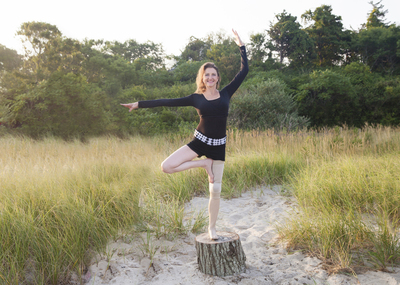 This is an interview with Marsha Danzig, founder and director of Yoga for Amputees, as well as Color Me Yoga for children. Marsha is a below-knee amputee helping others move forward in their lives through the healing power of yoga. Visit her online at Yoga for Amputees, Color Me Yoga and Fierce Joy.
This is an interview with Marsha Danzig, founder and director of Yoga for Amputees, as well as Color Me Yoga for children. Marsha is a below-knee amputee helping others move forward in their lives through the healing power of yoga. Visit her online at Yoga for Amputees, Color Me Yoga and Fierce Joy.
Rob: What originally motivated you to do this work, and what continues to motivate you? How, if at all, has that motivation changed over time?
My main motivation is helping people remember that they are already whole. I am an amputee, and yoga, to me, has always been about service to the world. I hoped that my years of teaching yoga would serve as an inspiration for other amputees to practice yoga. I knew after many years of practice and teaching so many of the intricacies of yoga as an amputee that I wanted to share my experiences and knowledge with others.
Is there a standout moment from your work with vets?
In one class a student was in bridge pose when he began to shake with emotion. He thought I was a "yoga genius" for the way I was teaching the pose, but really he was finally able to release trauma from the Vietnam War he thought he had already dealt with. I was very moved by his vulnerability.
What assumptions, if any, did you have in getting started?
I'm lucky enough to be an amputee, so I have never had assumptions about the amputee population; I just "get it."
What are two distinct ways that your teaching style differs from the way you might teach in a studio, and what are the reasons for these differences?
In a Yoga for Amputees class, I'm teaching to a broad spectrum of amputees with various levels of physical skills with or without their prostheses.
Two distinct ways my style differs are: My observation skills are even more heightened. It takes a special level of yoga teaching skill and intuition to know how to address the needs of my students. This means my approach is more in the moment, more improvisational, and much more creative. I love it! Second, many amputees are in various stages of grief, so there is a psychological component to the class that adds a therapeutic quality to it.
What has been the greatest challenge in your teaching experience, and what tools have you developed for addressing that challenge?
Many amputees are in serious pain. I'm always wishing I could offer even more solutions than I already do. The skill of listening goes a long way in a Yoga for Amputees class. Really listening to students in pain when they are describing their pain gives me clues, and ideas to support them come to me through listening. I often feel like the class is run by the Divine, and I am just in the orb of it, so I can trust the strange ideas I come up with -- they have never been wrong!
What advice would you give to anyone who is going to teach in the population you work with?
The advice that is the core of all my Yoga for Amputees trainings is:
- Be humble: See each student as 100 percent whole -- you are there to serve, not to fix. Be a beginner, be playful, be curious with each student -- you are really the student in this situation. They are the teachers. Let your students teach you by asking open-ended questions about their range of motion, level of capability, what their goals are in doing yoga.
What are some of your ideas about, or hopes for, the future of "service yoga" in America in the next decade?
I hope that some of the big yoga companies and yoga studios will really sink their money and time into sustainable yoga for everyone. I would also like to see automatic payment plans at studios around the country to donate to underserved yoga causes with every sign-up to a class or class series. I believe in dedicating a percentage of income to a cause you believe in. I would also like to see yoga trainings taught by at-risk kids to other at-risk kids: peer-to-peer yoga programs in neighborhoods.
How has this work changed your definition of service? Your definition of yoga? Your practice?
To be perfectly honest, it has not changed my definition of service. I have always found yoga to be a divine calling, so for me the privilege is witnessing people remember who they already are -- perfectly whole.
Editor: Alice Trembour
Stay connected with Give Back Yoga Foundation as we share the gift of yoga with the world, one person at a time, by following us on Facebook, Twitter and Google+ and by subscribing to our newsletter. Are you a yoga instructor giving back to underserved populations? E-mail Executive Director Rob Schware if you're interested in being interviewed for this series. Thanks for all that you do in the name of service!
